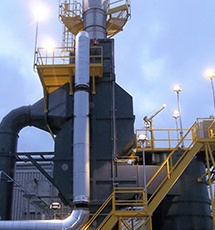Iron and steel foundries manufacture metal castings by melting iron and/or steel in a furnace, pouring the molten iron or steel into a mold of a desired shape, allowing the casting to cool (solidify) in the mold, removing the casting from the mold, and finishing (grinding and cleaning) the final cast product.
The primary processing units of interest at iron and steel foundries, because of their potential to generate Volatile Organic Compounds (VOCs) and Hazardous Air Pollutants (HAP) emissions, are the following: Metal melting furnaces; mold and core making lines; pouring, cooling, and shakeout (PCS) lines; and, if present, scrap preheaters.
- Melting furnaces primarily emit metal HAP.
- Mold and core making lines emit VOCs and HAP.

- Molds, which define the outer shape of the castings, are primarily made of sand, clay, and water (referred to as ‘‘green sand’’) with small amounts of coke added to maintain a reducing atmosphere and prevent oxidation of the metal while it is cooling.
- Cores, which are used to create internal void spaces in the casting, generally require more mechanical strength than molds and consist of sand mixed with a chemical binder to create a hard, durable form for the internal shapes. Depending on the size and shape of the casting, chemical binders may also be used in the mold sand to increase the strength of the molds. Many of the binder systems contain organic solvents, some of which may volatilize and be emitted during the sand resin-coating mixing process (i.e., mold and core making emissions).
- Pouring, Cooling, Shakeout (PCS) lines emit VOCs and HAP.

- Pouring - When the molten metal is poured in the sand molds, the hot metal causes the coke and/or organic chemical binders in the mold/cores to degrade and pyrolyze, which creates a variety of VOC and HAP emissions during the cooling.
- Shakeout process (where the hardened casting is removed from the sand molds).
- Sand Reclamation – In most foundry processes sand from collapsed molds or cores can be reclaimed or reused. The sand is cleaned and filtered and some new sand and binder is typically added to maintain the quality of the casting and to make up for sand lost during normal operation.
Catalytic Products International (CPI) completed the installation of a 55,000 SCFM Regenerative Thermal Oxidizer (RTO) at a Midwest USA iron foundry for the abatement of VOCs and HAPs generated during the mold cooling, shakeout, and casting cooling processes. The process emissions contain VOCs and HAPs including benzene, toluene, ethylbenzene and xylene (BTEX) and phenol. These process emissions are ducted to an existing Dust Collector pre-filtration system where particulate matter is removed from the exhaust stream prior to being ducted to the RTO. The RTO destroys the VOC and HAP emissions with 98.5% destruction rate efficiency (DRE) and achieves a thermal efficiency of 95% allowing the facility to exceed its air compliance goals and providing for minimal gas consumption and operating costs.
 Thermal treatment of VOCs and other air pollutants works by a simple reaction of the harmful hydrocarbon-based air pollutants with oxygen and heat. In this environment, the VOCs are oxidized to form harmless inert by-products like CO2, water vapor (H2O), and usable heat. These harmless by-products are released to the atmosphere or used within primary or secondary energy recovery techniques to further lower the operational costs.
Thermal treatment of VOCs and other air pollutants works by a simple reaction of the harmful hydrocarbon-based air pollutants with oxygen and heat. In this environment, the VOCs are oxidized to form harmless inert by-products like CO2, water vapor (H2O), and usable heat. These harmless by-products are released to the atmosphere or used within primary or secondary energy recovery techniques to further lower the operational costs.
CPI Regenerative Thermal Oxidizers (RTOs) are engineered to provide exceptional performance and reliability. During operation of the standard two chamber RTO, the VOCs are directed into one of the system’s regenerators, an internally insulated vessel containing specialized ceramic media which allows thermal rate efficiencies up to 97%. The contaminated gases are passed through the first regenerator where energy is transferred from the ceramic media to the gas in order to elevate the temperature. This elevated temperature approaches the ignition level for most solvents and is then directed from the ceramic bed into the combustion chamber. As the stream exits the ceramic bed and travels through the internally lined combustion chamber, minimal heat is added to ensure a proper oxidation temperature and a designed dwell time is maintained providing destruction of the VOCS at greater than 98% efficiency. The resultant clean, oxidized gases are directed to the second regenerator to absorb the heat energy before being released to the atmosphere. 
CPI provided engineering services including ductwork and damper design details and layout, foundation loading drawings, and support for the complete installation of the TRITON-55.95 Regenerative Thermal Oxidizer. CPI’s on-site supervision ensured coordination with the end customer and their subcontractors. This approach guaranteed that entire system was installed correctly, leading to a short start up and commissioning time frame, returning the customer to fully operational status with minimal downtime.
CPI has been “Enabling Clean Production Since 1969” and continues as a leading supplier of air pollution control equipment. CPI is at the forefront in providing industries including foundries with solutions to their air pollution control needs.
Today, CPI partners with its customers as a trusted resource in resolving the most complex air pollution and energy conservation problems. We provide our customers with innovative and cost-conscious solutions to their most complex VOC, NOx, and Odor pollution challenges. Our equipment is also at work meeting energy conservation strategies and minimizing greenhouse gas (GHG) emissions.








